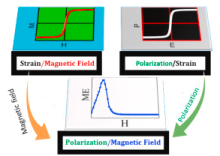Self-biased characteristics of NZCF/BCZT layered magnetoelectric composites: A novel coupling paradigm in magnetoelectricity
| Abstract | For the quest of energy efficient magnetoelectric (ME) technology and designing of multifunctional devices, the best from both ferroic family, i.e. ferroelectricity and ferromagnetism, are under consideration, in addition, also to ensure robust product functionality driven by electromechanical and magnetostriction phenomenon. However, presence of dc bias magnetic field is prerequisite during the operation of ME devices. This experimental catastrophe limits the application potential of ME devices, which may be significantly addressed via prearrangement of self-biasing mechanism in ME system. A system, with large ME coupling, exhibits realization of strong magnetic (electric) signals against the exposure to electric (magnetic) field. These stimulated signals of dc nature may be exploited for self-biasing and eliminates the necessity of field for operation. Here, we investigate room temperature ME behavior of ferroelectric Ba0.85Ca0.15Zr0.1Ti0.9O3 (BCZT) and ferrimagnetic Ni0.75Zn0.20Co0.05Fe2O4 (NZCF) layered composites. The ferroelectric ceramics (thickness, t, ~ 0.6, 0.8, and 1.0 mm) are stacked at magnetic specimen of fixed t ~ 1 mm, coupled with conducting silver epoxy. The phase formation, surface morphology, dielectric, magnetic, magnetoelectric and magnetodielectric characteristics of bilayer composites have been studied in the present work. The maximum value of magnetoelectric coupling coefficient (α_ME) is found to be 70, 90, and 110 mVcm−1Oe−1 for composite having ferroelectric layer thickness t ~ 1, 0.8, and 0.6 mm, respectively. More importantly, α_ME (H→0) remains finite for composite (t ~ 0.8, and 0.6 mm) in zero magnetic field, which is clear evidence of self-biasing phenomenon in NZCF/BCZT layered composite. For closer insight about underlying mechanism, we estimate magnetodielectric (MD) coefficient for the layered composite. The MD coefficient is found to be significantly high ~ 6.32% for the thickness 0.6 mm. MD% vs magnetic field, H, curves exhibit steeper field dependence in low field region and H≥2 kOe MD possess saturation characteristics. The high saturation characteristics suggests that magnetoelectricity in layered composite is driven by magnetostriction mechanism and causes robust ME coupling. Further, we obtain electrical signal ~ 143 mV with the Hdc ~250 Oe, as a consequence of interplaying nature of magneto(striction)- piezo(electricity). Such a sizeable response will improve the underlying intimacy between technology and practical application. The study reveals that pellet based layered composites may be a proven strategy for the realization of self-biased ME devices. |
| Faculty |
Sanjeev Kumar
|
|
sanjeev@pec.edu.in
|
|
| More Information |







